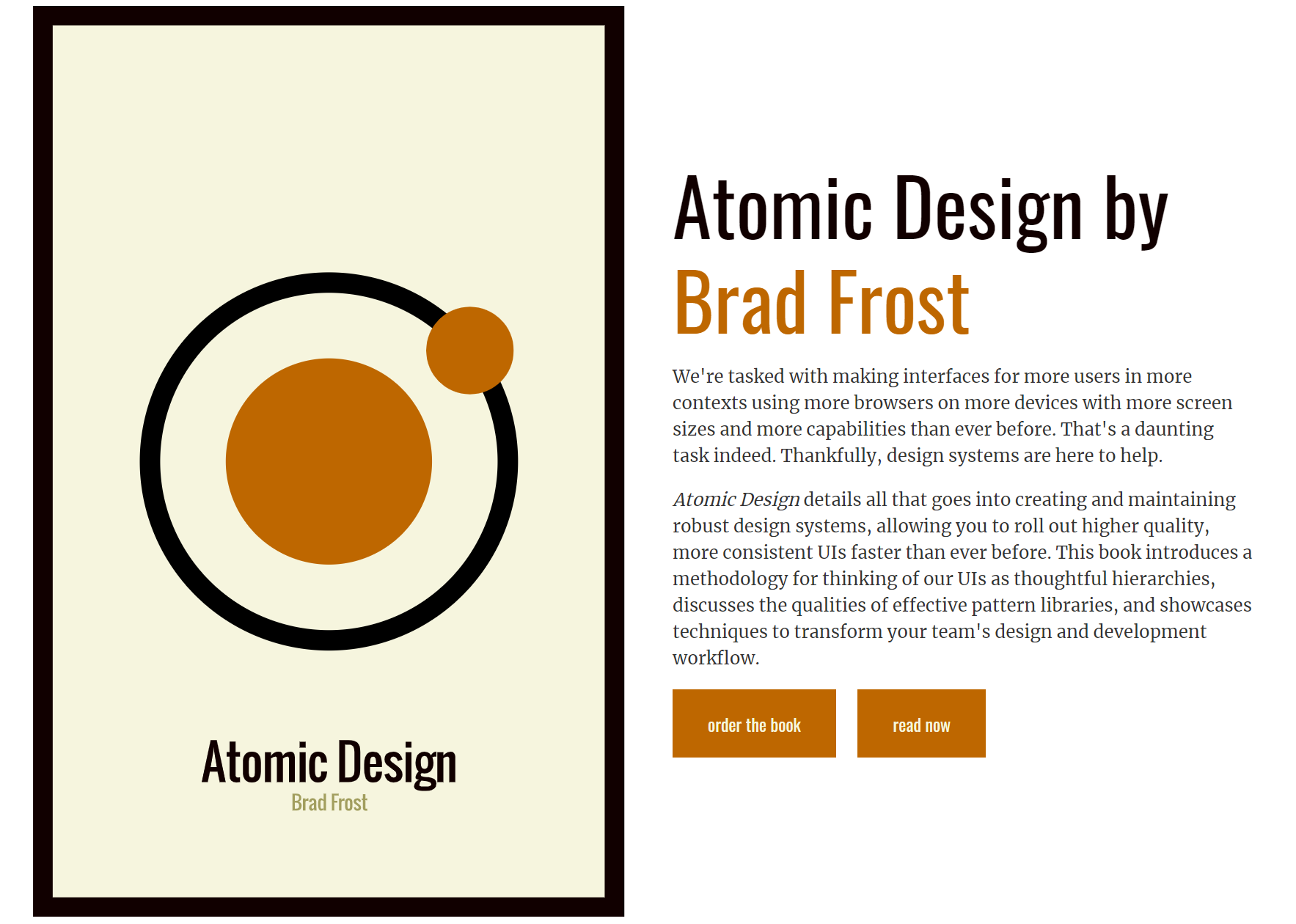Table Of Content

Here, placeholder content is replaced with real representative content to give an accurate depiction of what a user will ultimately see. Atomic design is blowing up around the world; it transformed our design practice; and we’re excited for it to bring the same creative combustion to your process, too. In the early stages of the TechCrunch redesign, there was this moment where we talked about what we wanted the article page to be.
Creating maintainable design systems
From the beginning, the page metaphor provided users with a familiar language with which to navigate this brave new World Wide Web. Concepts like bookmarking and pagination helped new web users explore and eventually master an entirely new medium using conventions they were already comfortable with. Atomic design provides a clear methodology for crafting design systems. Clients and team members are able to better appreciate the concept of design systems by actually seeing the steps laid out in front of them. Building up from molecules to organisms encourages creating standalone, portable, reusable components. Things start getting more interesting and tangible when we start combining atoms together.

Establishing content and display patterns
Design language style guides can (and usually do) incorporate aspects of other style guide categories in order to make high-level concepts a bit more tangible. The cornerstones of good design systems are style guides, which document and organize design materials while providing guidelines, usage, and guardrails. Not only is modularity infiltrating the code side of style on the web, it’s revolutionizing how visual designers approach modern web design. Thankfully, even massive organizations are taking cues from the smaller, leaner startup world and striving to get things out the door quicker.
Design Systems Smashing Magazine Discussion, April 2024
The screenshotting exercise can be a bit overwhelming, so be sure the team takes a break after the exercise is complete. Once everyone’s feeling refreshed, it’s time to discuss what you captured. Where we roll up our sleeves and put all of this theory into practice. This chapter will tackle all that goes into selling, creating, and maintaining effective design systems. For us to create experiences for this eclectic web landscape, we must evolve beyond the page metaphor that’s been with us since the birth of the web. Thankfully, organizations are embracing modularity across every aspect of the web creation process, which is leading to smarter work and more sustainable systems.
Using HTML templating languages (such as Mustache, Handlebars, Twig, Underscore, Jade, Nunjucks, and a slew of others) makes markup more portable and dynamic. Templating languages separate structure and data, and supercharge our HTML to keep us from having to write the same markup patterns over and over again. The good news is that many CMSes and application environments also make use of templating languages to serve up front-end markup. A UI design system manifests itself as the front-end of a web experience, which is comprised of HTML, CSS, and JavaScript.

With all this talk about modifying, adding, and removing patterns, you may be wondering, “How the hell are our applications supposed to actually keep up with all these changes?! ” And in asking that question, you will have stumbled on to one of the biggest challenges organizations face in successfully maintaining a design system. As mentioned a few times already, frequent communication and collaboration between makers and users is key for successfully governing your design system. Set up a design system Slack or Yammer channel, establish regular office hours, make sure your bug ticket software helps facilitate conversation, and keep the doors open for ad hoc chats and calls. If users are stuck on something, they should know exactly where and who to turn to for help.
It must be noted that this system is not free of the basic principles of UI/UX design. This means that the adoption of an atomic design does not mean the needs of users become secondary. The fundamental principles of design, such as a user-centered approach, familiarity, simplicity, and accessibility, take precedence, no matter which design framework is being followed. The presentation of atoms and molecules, alone or in combination, is essential for creating good templates and pages. This means that designers need to keep the UX principles of visual hierarchy and aesthetics in mind when working with the atomic methodology. When bringing atoms and molecules together, the focus should be on the individual efficacy of the elements as well as the collective impact on the user experience.
Atomic Prototyping: Fastest way to beautiful interactions - SitePoint
Atomic Prototyping: Fastest way to beautiful interactions.
Posted: Thu, 11 Jun 2015 07:00:00 GMT [source]
Don’t feel like you need to come to a consensus on patterns’ final names in the course of ten minutes; this exercise is simply meant to open up a broader discussion. I’ve encountered many ambitious designers and developers who have taken it upon themselves to start documenting their organization’s UI patterns. While I certainly applaud this individual ambition, it’s absolutely essential to get all members of the team to experience the pain of an inconsistent UI for them to start thinking systematically. While This Is Responsive is successful at articulating how these interface patterns can scale across screen sizes and environments, it’s still up to designers and developers to put these patterns into action. Atomic design is a system of building blocks adapted from chemical structures for effective interface design. The process is unique to the field of UI/UX as it carves out a strategy to design complicated systems by focusing on their parts as well as the whole at the same time.
While this principle existed long before the web was invented, it has taken some time for modularity to become engrained in the minds and hearts of web developers. Publishing content for the Web used to be a fairly straightforward endeavor, as the desktop web was the only game in town. Today, our content is consumed by a whole slew of smartphones, dumb phones, netbooks, notebooks, tablets, e-readers, smartwatches, TVs, game consoles, digital signage, car dashboards, and more.
After all, that’s what our clients pay us to do, and the products we create are the vehicles that generate money and success for our organizations. It seems natural to focus on the final implementations rather than the underlying system. The live products remain the primary focus of everyone’s attention, while any pattern library exists as an offshoot that simply provides helpful documentation. UX designers are hitting the prototype hard to make sure the flows and interactions are all logical and intuitive. Visual designers are combing over the interface and proposing design tweaks to the UI to polish up the design.
Again, I’m super happy with this process, and I’ll write about the many advantages of doing things this way in a future post. Unfortunately, most pattern libraries out in the wild don’t provide any hints as to when, how, and where their components get used. Style guides can be misunderstood as tools useful only to designers or developers, which leads to a lack of visibility that immediately limits their effectiveness. Instead of serving as a watering hole for everyone in the organization, a style guide can become a best-kept secret guarded by one discipline.
These contraptions were heavy and bulky and made from the pulp of dead trees. You can read more about the project here, sign up to the newsletter to receive project updates and resources, submit issues on Github, and track the progress of the project here. The header forms a standalone section of an interface, even though it contains several smaller pieces of interface with their own unique properties and functionality. My high school chemistry class was taught by a no-nonsense Vietnam vet with an extraordinarily impressive mustache.
It therefore becomes our responsibility to set client, colleague, and stakeholder expectations so that everyone knows the process for creating will be different this time around. By taking the time to organize the parts, you can now create the whole in a more realistic, deliberate, and efficient manner. Creating a library of your available materials allows you to approach the project in a more methodical way, and saves immense amounts of time in the process. Rather than rummaging through a haphazard pile of bricks and burning time reinventing patterns, you can create an organized system of components that will help produce better work in a shorter amount of time.
Within an hour, Brad had a fully responsive version wired up from his kit of parts. That was the moment we realized just how quickly we were going to be able to move, a powerful case for investing in this clever, modular approach. But without proper maintenance, the value of your design system will depreciate much like a car that’s just been driven off the dealer’s lot. Instead, your design system should be like a bottle of fine wine that increases in value over time.
Because we’re starting with a similar finite set of building blocks, we can apply that same process that happens in the natural world to design and develop our user interfaces. One important aspect of atomic design is that it separates the visual design from content in a clear manner. This means that now the content can be generated independently, still having a significant role in the entire framework. This is where a comprehensive content strategy becomes crucial to the success of the final product. Therefore, UI/UX designers need to work closely with content creators throughout the design process so the overall goals can be aligned and achieved effectively. A comprehensive content strategy would include all the details, from the text of a button to the introductory paragraphs on a web page, to ensure that there is consistency all around.

No comments:
Post a Comment